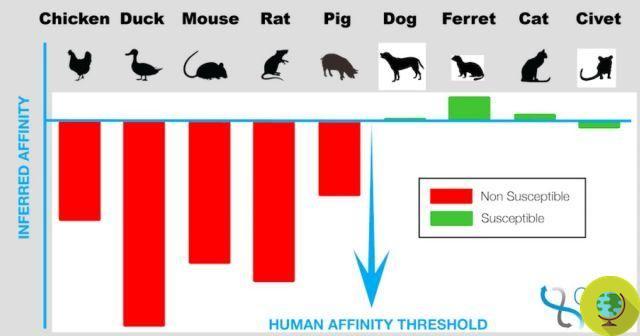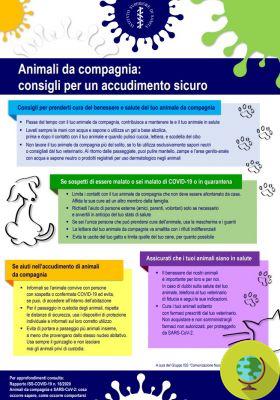Ferrets, cats and civets are the animals most susceptible to coronavirus infection after humans. Here because
Ferrets, dogs, cats and civets are the animals most susceptible to infection with coronavirus after man. Fewer are ducks, rats, mice, pigs and chickens. This was revealed by a new study conducted by researchers from the Center for Genomic Regulation (CRG), based in Barcelona.
It is now certain. Animals can also be infected and get sick. We discovered this with minks, unfortunately killed en masse all over the world to stem the infections. But other creatures can also contract Covid-19. To clarify is new research carried out in Spain that some animals are more likely to get sick, while others are less prone to the coronavirus.
According to the study, humans are the most susceptible but they are not the only ones. The analysis examined 10 species. Among these, 5 - humans, cats, ferrets, civets and dogs - had documented cases of SARS-CoV-2 infection while the other 5 showed no signs of infection (mice, rats, pigs, chickens and ducks).
"Knowing which animals are sensitive to SARS-CoV-2 helps us prevent the formation of animal reservoirs from which the coronavirus can re-emerge at a later time," explained Luis Serrano, ICREA research professor, director of the CRG and senior author of the study. “Our results offer a clue as to why i minks - which I am closely related to the ferret - they are infected by the disease, probably aggravated by their living conditions in crowded places (intensive farming, Ed) and by close contact with human workers ".
We remember in fact that it is not animals that infect humans but it is exactly the opposite. We infect these creatures, but fears related to mink concern a potential mutation of the virus that could render vaccines ineffective:
"Although we also find a potential susceptibility to infections by cats, they do not coexist with humans in the same conditions as other animals, which may explain why there are no known cases of people infected with their pets so far," adds Dr. Serrano.
A systematic review
The researchers used computer modeling to test how the coronavirus uses proteine spike, that "protrude" from its surface, to infiltrate the cells of various animals. The main point of entry on the surface of a cell is the ACE2 receptor, which binds to the spike protein. There are many different variants of ACE2 within human populations and between different species.
Variants of the ACE2 receptor in humans, as well as in ferrets, cats, dogs and civets have the highest binding affinities with the virus protein, while mice, rats, chickens and ducks have low binding energy.
However, binding affinity alone is not sufficient to assess a cell's susceptibility to infection. The researchers also tested the "codon adaptation index" of different species, which is how efficient the coronavirus is at "requisitioning" a cell once it enters. The more efficient the process, the better the coronavirus can create the proteins it needs to replicate.
Humans, chickens and ducks have the highest codon adaptation index. Putting the two factors together, i.e. considering both the binding affinity and the codon adaptation index, the researchers found that humans, followed by ferrets, cats, civets and dogs are the animals most susceptible to infection by coronavirus. But not only.

©CRG
"We have identified mutations on protein S that dramatically reduce the ability of SARS-CoV-2 to enter the cell, protecting the host from being captured by Covid-19," explains Javier Delgado, researcher at CRG. “We are now engineering mini-proteins from the human ACE2 protein to 'distract' the virus' attention from entering cells and blocking infection. If new ones arise mutations of the viral protein, we could design new variants to block them ".
A particularly important aspect given that for months now we have been talking about possible mutations related to mink.
On the other hand, months ago also the Istituto Superiore di Sanità had confirmed that
“The spread of SARS-CoV-2 virus infection in humans occurs through human contact. However, cats, ferrets, and to a lesser extent dogs are susceptible to infection with SARS-CoV-2. There is no evidence that pets have an epidemiological role in the spread of the virus to humans but there is the possibility that pets can become infected through contact with people with COVID-19 and occasionally develop disease "specifies. 'Higher Institute of Health.
The ISS has also provided a vademecum to protect animals in the event that it is discovered positive for Coronavirus:

©ISS
Sources of reference: CRG, PLOS Computational Biology
READ also:
- Dogs, cats and coronavirus: enough useless and dangerous alarmism. The interview with the Experimental Zooprophylactic Institute of the Venezie
- Coronavirus: Cats and dogs are not contagious, but they can get sick. The advice of the ISS to protect them
- Serological tests on Vo 'domestic cats. The study is underway to show that cats do not transmit the coronavirus


























